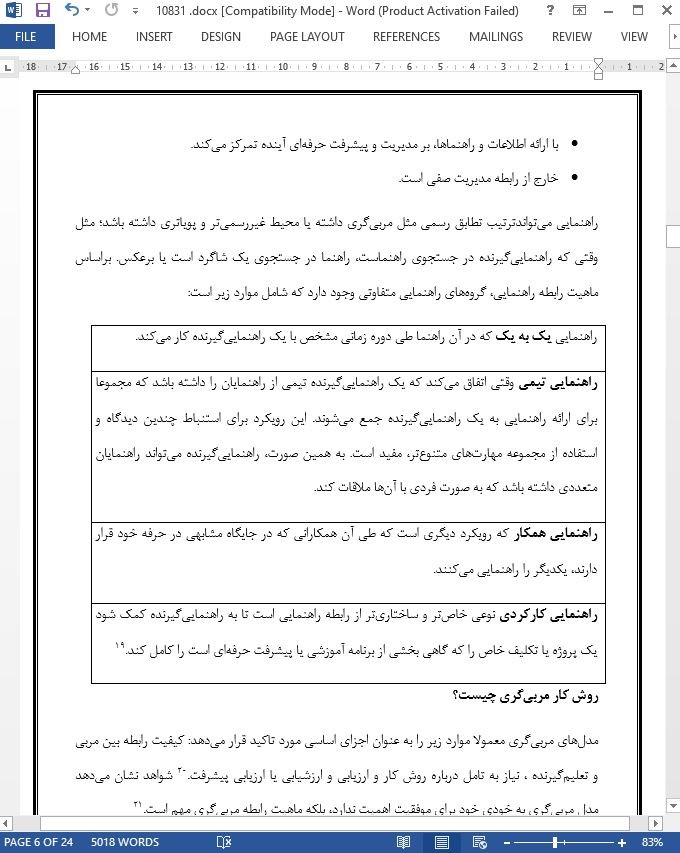
مربی گری و راهنمایی برای متخصصین خط مقدم
مقدمه
پشتیبانی و پرورش متخصصین خط مقدم که با کودکان، جوانان و خانوادهها کار میکنند در سالهای اخیر اهمیت افزایندهای یافته است که به دلیل تقاضای بیشتر خدمات و انتظارات از متخصصین است. بویژه حرفههایی مثل تدریس، پرستاری و مددکاری اجتماعی با مسائل نگهداری و فرسودگی کارمندانروبرو هستند. نیازهای ارائه خدمات که بر دوش متخصصین خط مقدم است میتواند منجر به چشمپوشی از نیازهای حرفهای و شخصی خود آنها شود. استفاده از مربیگری و راهنمایی به عنوان مداخلات پشتیبانی و ظرفیتسازی برای متخصصین در حال رشد است. این روشها به عنوان رویکردهایی شناسایی میشوند که منافع تکمیلی برای رویکردهای سنتی آموزش ارائه میدهند.
مربیگری چیست؟
تعریف مورد توافقی برای مربیگری در مقالات وجود ندارد. این عبارت به جای راهنمایی و گاهی مشاوره به کار رفته است. همه این رویکردها از رفتارهای «کمککننده» استفاده میکنند. مربیگری به این دلیل متمایز است که رابطه کمککننده مشارکتی بین مربی و تعلیمگیرنده بوده و متمرکز بر کار به روش سیستماتیک در جهت اهداف مورد توافق است تا عملکرد حرفهای ارتقا یافته، یادگیری خودگردان پرورش یابد، رضایت و رشد شخصی افزایش یابد. معمولا سه طرف در زمینه محیط کار برای توافق مربیگری وجود دارد: مربی، تعلیمگیرنده و سازمان آنها. توافق مربیگری (گاهی به عنوان قرارداد خوانده میشود) اهدافی را برای مربیگری تعیین میکند. این امر به کار بین مربی و تعلیمگیرنده جهت میدهد. مربیگری به عنوان یک رشته علمی از چند زمینه مطالعاتی از جمله روانشناسی، مربیگری ورزشی و تجارت حاصل میشود.
Introduction
Support and development for front-line practitioners who work with children, young people and families has become increasingly important in recent years due to greater demands on services, and practitioners themselves. Professions such as teaching, nursing and social work in particular are experiencing issues with staff retention and burnout. The service delivery demands on front line practitioners can lead to neglect of their own professional and personal needs. The use of coaching and mentoring as support and capacity building interventions for practitioners is growing. These are recognised as approaches which offer additional benefits to traditional training approaches.
What is Coaching?
There is no single agreed definition of coaching in the literature. The term is often used interchangeably with mentoring and sometimes counselling. All of these approaches use ‘helping’ behaviours. Coaching is distinct in that it is a collaborative helping relationship between a coach and coachee, which is focused on working in a systematic way towards agreed goals to enhance professional performance, foster ongoing self-directed learning, increase personal satisfaction and personal growth.2 In a work place context, there are typically three parties to a coaching agreement: the coach, coachee and their organisation. The coaching agreement (sometimes referred to as the contract) sets out the goals for the coaching. This directs the work between the coach and coachee. As a discipline, coaching draws from a number of areas of study including psychology, sports coaching and business.3

مقدمه
مربیگری چیست؟
راهنمایی چیست؟
روش کار مربیگری چیست؟
روش کار راهنمایی چیست؟
مربیگری چه تفاوتی ایجاد میکند؟
راهنمایی چه تفاوتی ایجاد میکند؟
مربیگری و راهنمایی چه تفاوتی در رویکردهای سنتیتر آموزش و تعلیم دارند؟
راهنماهای عملی
Introduction
What is Coaching
What is Mentoring
What works in Coaching?
What works in Mentoring?
What difference does coaching make?
What difference does mentoring make?
How are coaching and mentoring different to more traditional approaches to training?
Practice Guidelines
- اصل مقاله انگلیسی با فرمت ورد (word) با قابلیت ویرایش 222222222
- ترجمه فارسی مقاله با فرمت ورد (word) با قابلیت ویرایش، بدون آرم سایت ای ترجمه
- ترجمه فارسی مقاله با فرمت pdf، بدون آرم سایت ای ترجمه
